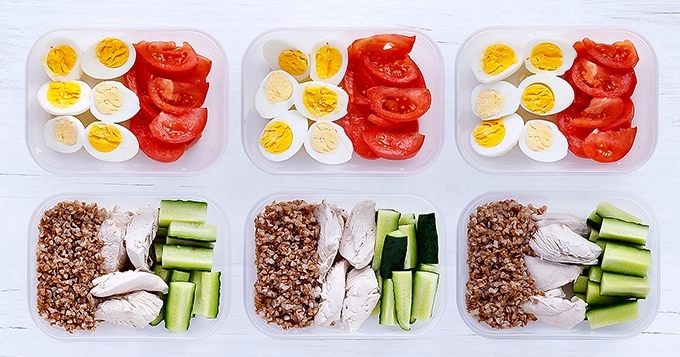Achieving a toned body isn’t just about the aesthetics; it is a testament to dedication and a commitment to overall health. Whether aiming at how to get toned muscles or simply striving for a leaner silhouette, understanding how to tone up your body effectively is critical. Toned muscles enhance physical appearance and contribute significantly to functional strength and endurance, making everyday tasks easier and more enjoyable.
Adopting a holistic approach that integrates balanced nutrition, targeted exercise routines, and adequate rest is crucial to achieving a toned body. This journey involves more than just following exercise routines or making temporary dietary changes; it’s about crafting a sustainable lifestyle that supports your fitness goals and enhances your overall well-being.
-
Establish a Balanced Diet
A balanced diet is the cornerstone of any journey to tone up body and achieve a leaner, more defined physique. This commitment supports your workouts, fuels muscle growth, and promotes overall health, giving you a sense of accomplishment and inspiring you to continue your fitness journey.
Nutrient Essentials
Focus on consuming a balanced mix of macronutrients to tone muscles and reduce body fat. Lean protein sources, including beans, fish, poultry, and tofu, are crucial for constructing and mending muscle. For long-lasting energy, include complex carbs like those found in fruits, vegetables, and whole grains. This understanding will prepare you for your workouts, ensuring you maintain the intensity needed for effective toning.
Healthy fats from sources like avocados, nuts, and olive oil help produce hormones and help absorb fat-soluble vitamins, contributing to overall metabolic health.
Portion Control
Achieving a toned body also requires managing portion sizes to align with your energy expenditure and fitness goals. At each balanced meal, try to eat palm-sized portions of protein, fist-sized portions of carbs, and thumb-sized portions of healthy fats. This method ensures you get the nutrients you need without going overboard with foods high in calories, which could impede your efforts to get a leaner body.
Hydration
Although sometimes disregarded, enough hydration is essential for general health and muscle performance. Drinking adequate water throughout the day supports nutrient transport, temperature regulation, and joint lubrication. Try to drink eight glasses of water or more each day, varying your consumption according to your activity level and the surroundings.
Strategic Eating
Incorporate strategic eating habits to maximize your body’s ability to tone up. Consume well-portioned, smaller meals every three to four hours to sustain consistent energy levels and avoid overindulging. Pre and post-workout nutrition are significant: consume a combination of protein and carbohydrates before exercise to fuel your workouts and refuel with protein and a small amount of carbohydrates afterward to support muscle recovery and growth.
-
Do Strength Training
Strength training is pivotal to building a tone body. It is the most effective way to develop toned muscles, increase metabolism, and achieve a leaner appearance. Strength training also helps improve overall muscle definition and sculpt your body as part of your fitness regimen.
The Importance of Strength Training
Strength training helps develop muscle mass, which in turn boosts metabolism. Even at rest, this higher metabolic rate helps burn calories more effectively, significantly contributing to a toned figure. Additionally, strength training improves bone density, joint health, and overall functional strength, making daily activities more accessible and reducing the risk of injuries.
Types of Strength Training Exercises
You can incorporate various strength training activities into your program to tone up your body. These include:
- Bodyweight Exercises: These bodyweight workouts, which include lunges, squats, and push-ups, are great for toning your muscles since they use your body weight as resistance.
- Free Weights: Dumbbells, kettlebells, and barbells allow for a wide range of motion and targeted muscle groups, promoting muscular growth and definition.
- Resistance Bands: These bands provide adjustable resistance and add variety to your workouts. They also help tone muscles effectively.
- Machines: Weight machines can help beginners safely maintain proper form and target specific muscle groups.
Progressive Overload
To progress and tone your body continually, it’s essential to incorporate the principle of progressive overload. This means gradually increasing your exercise’s weight, resistance, or intensity over time. Challenging your muscles stimulates growth and strength, leading to more defined and toned muscles.
Consistency and Frequency
Consistency is critical to achieving and maintaining a toned body. Make it a goal to perform strength training exercises three or four times a week, with each session concentrating on a different muscle area to guarantee balanced development. A typical split might include:
- Day 1: Upper body (shoulders, triceps, and chest)
- Day 2: Lower body (hamstrings, glutes, and quadriceps)
- Day 3: Active recovery (mild cardio, stretching) or rest
- Day 4: Back and biceps
- Day 5: Core and legs
- Day 6: Full-body workout
- Day 7: Rest
Form and Technique
Proper form and technique are essential to avoid injuries and guarantee proper muscle activation. Don’t speed through your repetitions; concentrate on using calm motions to complete each exercise. Learn the proper form by working with a personal trainer or fitness specialist, particularly if you’re new to strength training.
Variety and Adaptation
Incorporate various exercises and regularly change your routine to prevent plateaus and keep your workouts engaging. Varying the kinds of workouts you undertake, the order in which you perform them, and the equipment you utilize can regularly challenge your muscles and encourage growth.
-
Incorporate Cardiovascular Exercise
Cardio helps burn calories, reduce body fat, and enhance cardiovascular health and overall endurance. It complements strength training efforts to tone muscles and sculpt a lean physique.
The Role of Cardio in Toning Up
Cardiovascular exercise helps create a calorie deficit essential for fat loss. Reducing excess body fat makes your toned muscles more visible, contributing to a leaner appearance. Additionally, regular cardio improves heart and lung function, increasing your stamina and enabling you to perform more intense workouts, further aiding in your efforts to tone up your body.
Types of Cardiovascular Exercise
Various forms of cardio exercises can help you tone up your body. You can modify these workouts to fit a variety of fitness levels and preferences:
- High-Intensity Interval Training (HIIT): HIIT entails brief high-intensity exercise interspersed with low-intensity workouts or rest periods. This exercise is excellent for increasing muscular tone, metabolism, and burning calories. Burpees, jumping jacks, and running are a few examples.
- Steady-state Cardio involves maintaining consistent moderate-intensity exercise for an extended period. This includes exercises like cycling, swimming, jogging, and brisk walking. A cardio with a steady state is excellent for burning fat and increasing endurance.
- Aerobic Classes: Group classes such as Zumba, kickboxing, and step aerobics can make cardio fun and engaging. These classes often combine rhythmic movements with resistance exercises, helping to tone muscles while improving cardiovascular fitness.
- Circuit training combines strength exercises with short bouts of cardio. This method increases heart rate and works for various muscle groups, giving you a full-body workout that burns calories and tones muscles.
Frequency and Duration
To properly tone your body and improve your cardiovascular health, do at least 150 minutes of moderate-intensity or 75 minutes of high-intensity cardio each week. Depending on your schedule and fitness level, this can be broken down into 30-minute sessions five times a week or shorter, more intense sessions.
Combining Cardio with Strength Training
For optimal results in how to get toned muscles, it’s essential to balance cardio with strength training. When you perform strength training, you can include a short, high-intensity cardio session before or after your workout. Alternatively, dedicate specific days to cardio, ensuring you don’t overtrain and allowing your muscles time to recover.
Listening to Your Body
Pay attention to how your body responds to different cardio exercises. Mix and match various forms of cardio to keep your workouts exciting and to prevent overuse injuries. Incorporating low-impact activities like swimming or cycling can make your joints easier while providing practical cardiovascular benefits.
-
Recover and Rest
Recovery and rest are crucial yet often overlooked components of any fitness program to achieve a toned body. With the right rest and recuperation, your muscles may heal, develop, and get stronger, eventually resulting in more toned and defined muscles. Adequate recovery can avoid overtraining, injuries, and diminished results.
The Importance of Rest Days
Rest days are essential for muscle recovery and overall health. Strength training and cardiovascular exercises create micro-tears in muscle fibers. During rest, your body repairs these tears, increasing muscle growth and strength. Including regular rest days in your workout regimen lowers your chance of injury, prevents overtraining, and gives your muscles enough time to grow and heal.
Sleep and Muscle Recovery
Quality sleep is vital for anyone looking to tone up. Your body releases growth hormones as you sleep, which promotes muscle growth and repair. Aim for 7-9 hours of uninterrupted sleep each night to support your fitness goals. To optimize the effects of sleep on muscle healing, set up a regular sleep schedule, develop a calming nighttime ritual, and ensure your sleeping space is restful.
Active Recovery
On rest days, active recovery entails low-intensity exercise to increase blood flow and facilitate muscle healing. Light walking, gentle yoga, or stretching can help reduce muscle soreness, improve flexibility, and enhance overall recovery without placing additional stress on your muscles. By including active recovery into your routine, you can keep up your workout routine consistently while allowing your body to repair.
Flexibility and Mobility Exercises
Incorporating flexibility and mobility exercises into your routine is essential for maintaining a toned body. Stretching helps improve muscle elasticity, reduce muscle tightness, and enhance your range of motion. Performing dynamic stretches before working out, including arm circles and leg swings, is essential to prepare your muscles for activity. Static stretches, such as hamstring and quad stretches, are best performed after workouts to aid muscle recovery and reduce soreness.
Nutrition for Recovery
A healthy diet is essential for muscular growth and recuperation. After exercise, a well-balanced meal containing protein and carbohydrates can aid in the repair of muscle tissue and the replenishment of glycogen levels. Protein sources such as fish, eggs, lean meats, and plant-based proteins can provide the amino acids required for muscle regeneration. Carbohydrates from whole grains, fruits, and vegetables help restore energy levels and support overall recovery.
Stress Management
Managing stress is essential for maintaining a toned body and overall well-being. Chronic stress can increase cortisol levels, negatively impacting muscle recovery and fat loss. Incorporate stress-relieving techniques like meditation, deep breathing exercises, and enjoyable hobbies to enhance physical and mental relaxation.









